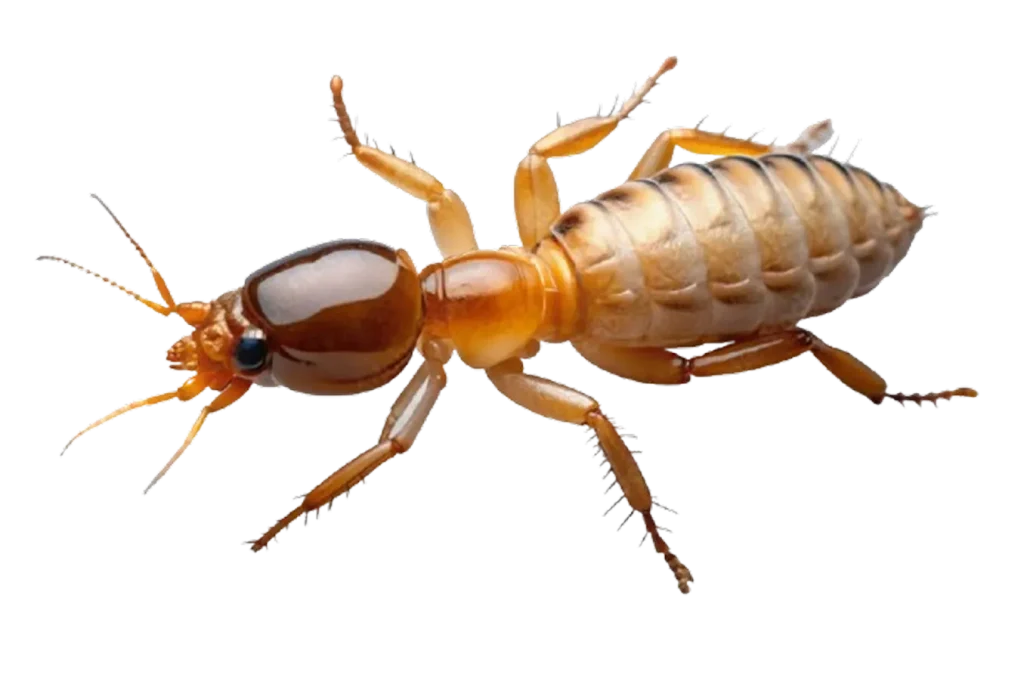
TERMITE
Common name: Termite
Size: 1/8 inch to 1 inch
Life Span: 1–2 years.
Termites are social insects that live in large colonies, often hidden beneath the soil, inside wood, or within walls. They thrive in warm, humid environments and are found in forests, grasslands, and urban areas. Unlike ants, termites do not have a narrow waist, and their wings, when present, are of equal size. A colony consists of a queen, king, workers, soldiers, and reproductive termites. The queen is responsible for laying eggs, while workers build tunnels, gather food, and care for the young. Soldiers protect the colony from threats, especially ants. Subterranean termites build elaborate underground tunnels and require constant moisture, while dry wood termites infest wooden structures without needing soil contact.
Their diet consists mainly of cellulose, found in wood and plant materials, making them one of nature’s primary decomposers. However, their ability to consume wooden structures poses a serious threat to buildings and furniture. Termites often remain undetected for years, silently hollowing out wood from the inside. Signs of an infestation include mud tubes on walls, hollowed-out wood, discarded wings near windows and doors, and fine sawdust-like droppings from dry wood termites.
As pest
Termites are among the most destructive household pests, causing extensive damage before their presence is even noticed. They weaken wooden structures by consuming them from the inside, making homes and buildings vulnerable to collapse over time. Their ability to stay hidden means infestations often go unnoticed until significant damage has occurred. Subterranean termites, the most common type, create mud tunnels to travel between their nests and food sources, often damaging foundations, beams, and flooring. Drywood termites, on the other hand, live entirely inside wood and can infest furniture, doors, and window frames. Unlike other pests, termites do not bite or spread diseases, but their structural damage results in costly repairs.
Homeowners may notice sagging floors, buckling walls, or doors that no longer close properly due to termite activity. When termite colonies grow too large, they produce winged reproductive termites, known as swarmers, which fly out in search of new locations to establish colonies. Spotting swarmers indoors is a major red flag. Since termite damage is not always covered by insurance, prevention and early detection are crucial. Without intervention, a single termite colony can consume several feet of wood each year, leading to severe structural instability.

How to control
Effective termite control involves a combination of prevention, early detection, and professional treatment. Regular inspections of wooden structures, basements, and crawl spaces help identify early signs of infestation. Eliminating excess moisture by fixing leaks, improving ventilation, and maintaining proper drainage reduces the chances of attracting termites. Keeping firewood, wooden debris, and untreated lumber away from homes prevents easy access. Subterranean termites are controlled using liquid termiticides, which create a chemical barrier in the soil to kill termites before they reach a building.
Baiting systems attract termites to poisoned food sources, which they carry back to the colony, eliminating large numbers over time. Drywood termites require localized treatments, such as direct chemical application or whole-structure fumigation in severe cases. Sealing cracks in walls and foundations helps prevent termite entry. Since these pests are highly resilient, professional pest control services are often necessary for complete eradication. Regular monitoring is essential, as untreated infestations can return. Investing in termite-resistant materials for construction, such as treated wood or concrete barriers, adds another layer of protection. Early intervention is key to preventing costly damage, making routine inspections an essential part of property maintenance.

